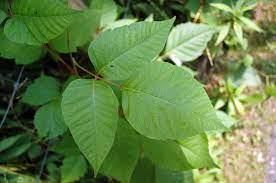Leaves of Three, Let It Be!
go.ncsu.edu/readext?872508
en Español / em Português
El inglés es el idioma de control de esta página. En la medida en que haya algún conflicto entre la traducción al inglés y la traducción, el inglés prevalece.
Al hacer clic en el enlace de traducción se activa un servicio de traducción gratuito para convertir la página al español. Al igual que con cualquier traducción por Internet, la conversión no es sensible al contexto y puede que no traduzca el texto en su significado original. NC State Extension no garantiza la exactitud del texto traducido. Por favor, tenga en cuenta que algunas aplicaciones y/o servicios pueden no funcionar como se espera cuando se traducen.
Português
Inglês é o idioma de controle desta página. Na medida que haja algum conflito entre o texto original em Inglês e a tradução, o Inglês prevalece.
Ao clicar no link de tradução, um serviço gratuito de tradução será ativado para converter a página para o Português. Como em qualquer tradução pela internet, a conversão não é sensivel ao contexto e pode não ocorrer a tradução para o significado orginal. O serviço de Extensão da Carolina do Norte (NC State Extension) não garante a exatidão do texto traduzido. Por favor, observe que algumas funções ou serviços podem não funcionar como esperado após a tradução.
English
English is the controlling language of this page. To the extent there is any conflict between the English text and the translation, English controls.
Clicking on the translation link activates a free translation service to convert the page to Spanish. As with any Internet translation, the conversion is not context-sensitive and may not translate the text to its original meaning. NC State Extension does not guarantee the accuracy of the translated text. Please note that some applications and/or services may not function as expected when translated.
Collapse ▲Leaves of three, let it be! To many, poison ivy conjures images of itchy rashes and calamine lotion. Fun, summertime activities like hiking, biking, fishing, and gardening can put us in direct contact with this nuisance plant. All parts of poison ivy, including the roots, are poisonous at all times of the year!
In order to better enjoy your outdoor activities (and not suffer the itchy consequences of an encounter with poison ivy), become acquainted with poison ivy and be able to easily identify the plant. One of the best ways to prevent a rash, is to avoid contact with the plant.
“Leaves of three, let it be!” Poison ivy always has three leaflets that make up the leaf. Sometimes, the shape of the leaf may vary from plant to plant, but never the  number of leaflets. Poison ivy is often confused with Virginia creeper, a low-growing vine that has similar looking leaves. However, Virginia creeper has leaves with three to five leaflets, all occurring on the same plant – this plant will not cause a rash. If you see five leaflets, the plant is not poison ivy.
number of leaflets. Poison ivy is often confused with Virginia creeper, a low-growing vine that has similar looking leaves. However, Virginia creeper has leaves with three to five leaflets, all occurring on the same plant – this plant will not cause a rash. If you see five leaflets, the plant is not poison ivy.
“Hairy vine, no friend of mine!” Poison ivy can occur as a woody shrub, a trailing shrub, or a vine with hairy aerial roots. Many times you will see the hairy vine growing up large trees. Be careful, all parts of poison ivy are poisonous.
“Berries of white, danger in sight.” Poison ivy flowers in the summer and produces waxy-looking, white berries in the fall. Birds love the berries and spread the seeds everywhere.
Poison ivy causes an allergic reaction on many people – some people are less susceptible. Susceptibility of an individual can change over time. The plant produces an oil called urushiol, which is easily released when the plant is bruised or brushed up on. A reaction usually occurs within 12 to 48 hours after the contact. Sometimes the itching will last over ten days. In cases of a severe reaction, see your doctor.
If you know you will be in areas with lots of poison ivy, wear long pants, long-sleeved shirts, boots, and gloves. Wash your hands and other body parts that may have contacted poison ivy thoroughly with soap and cool water. Remove clothing before sitting or touching anything in your house. Wash contaminated clothes separately from your family’s everyday clothes.
One last caution, do not burn plants that resemble poison ivy! Inhalation of smoke resulting from the burning of poison ivy can cause severe reactions.
Having poison ivy can be the pits! To avoid an itchy summer, be sure to learn plant identification in order to avoid contact and wash your body thoroughly after a fun day outside. And make sure you properly identify poison ivy before you attempt any control measures. Poison ivy foliage within reach can be sprayed with glyphosate (sold under the trade names Roundup, Kleenup and others) according to label directions. When using this or any herbicide, always read and follow label directions carefully. Glyphosate is a nonselective herbicide and will kill any vegetation it contacts. To kill poison ivy that climbs high into trees, cut the vine off 6 inches above ground level. Treat the stump with glyphosate (according to label directions) immediately after cutting to kill the roots and prevent sprouting. If re-sprouting does occur, treat the leaves with glyphosate. Poison ivy can be very persistent, so you may have to spray the vines two or more times for complete control. This method works pretty well if you are trying to get rid of wisteria. For more information on poison ivy identification and control contact our Center at 919-775-5624.




